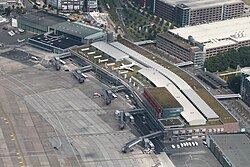Bremen Airport
|
Bremen Airport Flughafen Bremen |
|||||||||||||||
|---|---|---|---|---|---|---|---|---|---|---|---|---|---|---|---|
 |
|||||||||||||||
| Summary | |||||||||||||||
| Airport type | Public | ||||||||||||||
| Operator | Flughafen Bremen GmbH | ||||||||||||||
| Serves | Bremen, Germany | ||||||||||||||
| Focus city for | |||||||||||||||
| Elevation AMSL | 14 ft / 4 m | ||||||||||||||
| Coordinates | 53°02′51″N 008°47′12″E / 53.04750°N 8.78667°ECoordinates: 53°02′51″N 008°47′12″E / 53.04750°N 8.78667°E | ||||||||||||||
| Website | airport-bremen.de | ||||||||||||||
| Map | |||||||||||||||
| Location of airport in Bremen | |||||||||||||||
| Runways | |||||||||||||||
|
|||||||||||||||
| Helipads | |||||||||||||||
|
|||||||||||||||
| Statistics (2016) | |||||||||||||||
|
|||||||||||||||
|
Source: German AIP at EUROCONTROL
|
|||||||||||||||
| Number of Passengers | 2 .573. 501 |
|---|
Bremen Airport (German: Flughafen Bremen) IATA: BRE, ICAO: EDDW) is the international airport of the city and state of Bremen in Northern Germany. It is located 3.5 km (2.2 mi) south of the city and handled 2.66 million passengers in 2015. It mainly features flights to European metropolitan and leisure destinations and serves as a base for Germania and Ryanair.
The beginnings of the airport date back to the early 20th century. The Bremer Verein für Luftschiffahrt, a local aerospace club, conducted the first experimental flights at the present site in the summer of 1910, on what was then the parade ground of the local garrison. The Senate of Bremen supported the establishment of an airfield to connect Bremen to the growing airship route network. Official permission for the opening of an airport was granted on 16 May 1913. The initial infrastructure was geared towards aircraft operations instead of the initially envisaged airships. Several wooden hangars were erected.
During World War I, the airport was taken into military administration, and civilian operations ceased. The military erected a wooden hangar, but conducted only a small number of operations from the airfield. After the war, the airport only reopened on 18 July 1920, with Dutch airline KLM beginning scheduled flights to Amsterdam soon thereafter. In the same year, the Weimar National Assembly authorised investment into upgraded facilities at the airport. Administration of the airport was transferred to the newly founded Bremer Flughafengesellschaft. In 1923, the aeroplane manufacturer Focke-Wulf was founded on a site adjacent to the airfield.
In the 1930s, several new terminal buildings and hangars were constructed, with the largest to date being completed in 1937. In the same year, four new runways were built. These were arranged in a star-like pattern. The increasing military buildup under the rule of the Nazis also began to show itself at the airport, with the Luftwaffe establishing a flight training base there. Civilian operations again came to a standstill with the beginning of World War II. For a short period between November 1939 and June 1940, the airport served as the base for a squadron of Focke-Wulf Fw200 bombers. In the later stages of the war, the airport came under repeated bombardment due to co-location with the Focke-Wulf plant. This left most of the infrastructure destroyed or severely damaged by the end of the war.
...
Wikipedia

